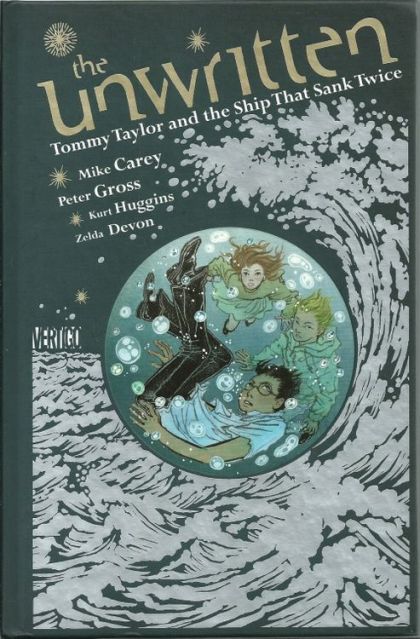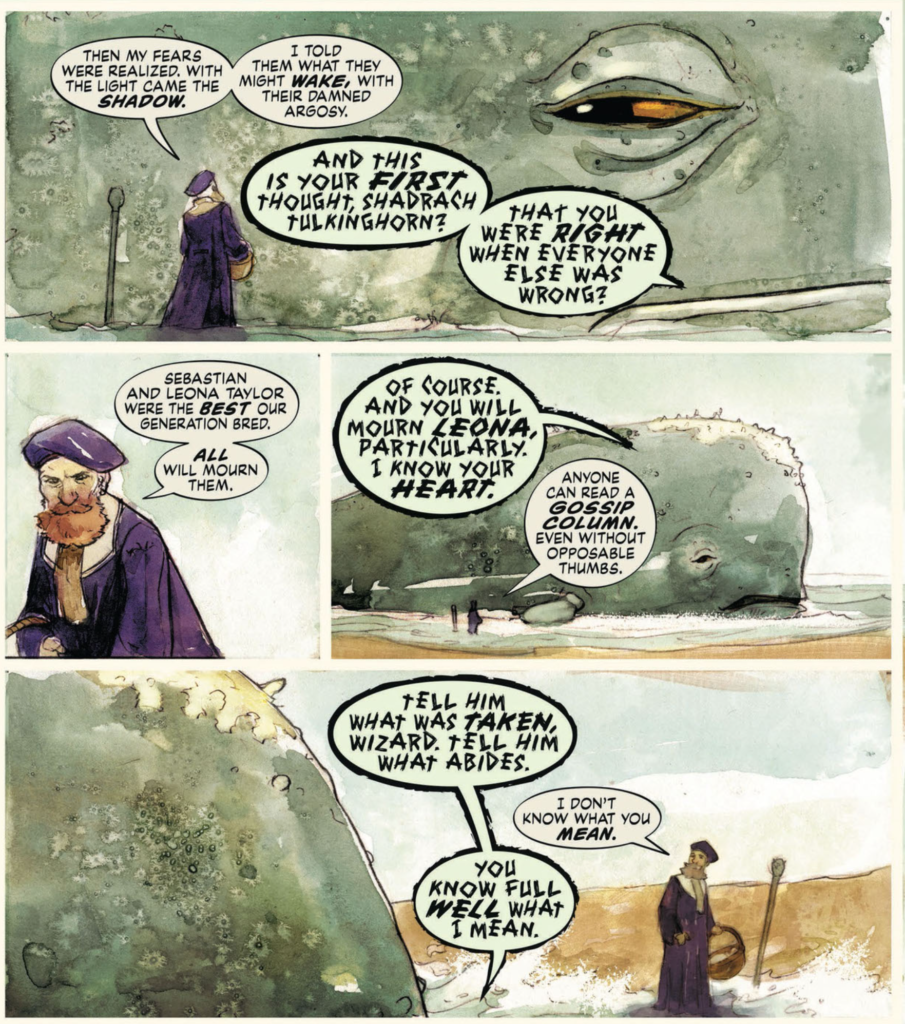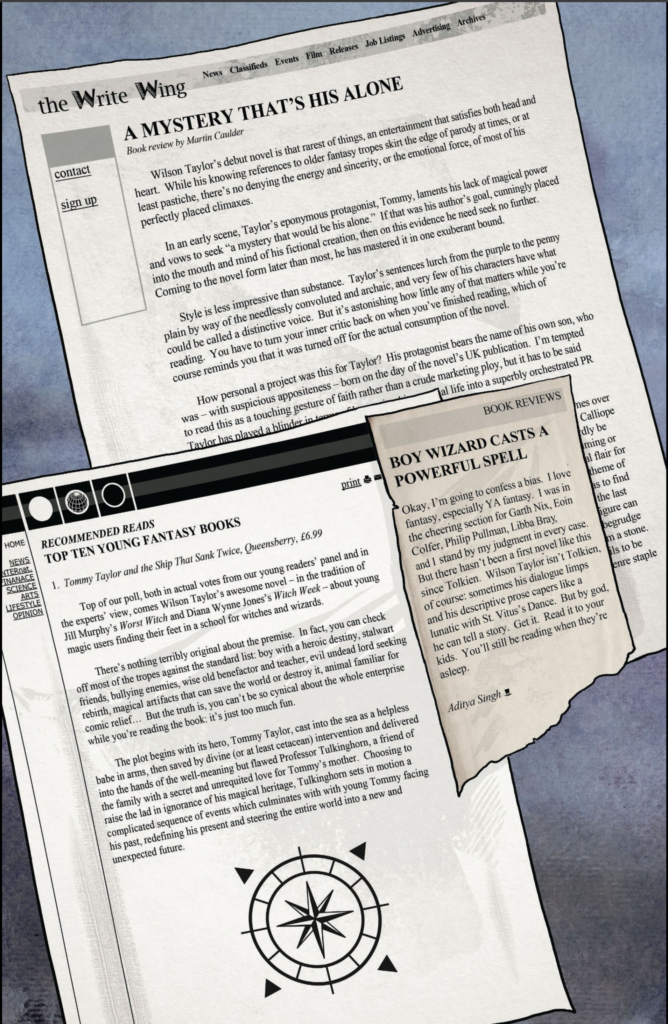Unbagging The Unwritten: Tommy Taylor And The Ship That Sunk Twice
The Unwritten: Tommy Taylor and the Ship That Sunk Twice

Release: Sep 18, 2013

This exciting, original graphic novel explores the world of the Tommy Taylor novels in a visceral and direct way and is a great entry point for new readers. Twenty-five years ago Tom’s father, Wilson Taylor, devised his subversive literary masterpiece. Now the blueprint of how a father gave his son vast power in order to accomplish a greater scheme is revealed. Partly told through Wilson’s own journal entries, juxtaposed with Tommy’s swashbuckling deep sea adventures with his trusty companions Peter and Sue, the story is at once a prequel and a parallel story to the ongoing series.
Creators
| Writer | Mike Carey |
| Cover Artist | Yuko Shimizu |
| Penciller | Peter Gross, Shawn McManus, Gary Erskine, Russell Braun, Kurt Huggins, Dean Ormston, Al Davison |
| Colorist | Eva de la Cruz, Al Davison, Zelda Devon, Chris Chuckry, Jeanne McGee |
| Layouts | Peter Gross |
| Editor | Pornsak Pichetshote, Greg Lockard, Shelly Bond |
Leviathan stole our baby.
A recent discussion on Bluesky prompted by a “Comic Book Alphabet” post got me to thinking about how I don’t see enough people talking about The Unwritten, a Vertigo series written by Mike Carey and illustrated by Peter Gross that ran from 2009 to 2015. It was split up into two parts, with the first being titled simply The Unwritten, and the second titled The Unwritten: Apocalypse.
Additionally, there was an original graphic novel released in 2013, which is the subject of today’s Unbagging as I try to do my part to rectify the problem of not enough people talking about the series, as I feel it needs to be spoken about as much as other classic Vertigo titles.
The series focuses on a man named Tom King Tom Taylor – no, not that one, though given what the book is about, I was amused the first time I encountered that Tom Taylor’s name in a comic – whose (allegedly) late father was an author named Wilson Taylor.
Wilson Taylor is world famous for a series of immensely popular fantasy novels about a boy named Tommy Taylor.
The books were written throughout Tom’s childhood, and now, as an adult, Tom has to navigate a world in which he’s famous simply because of his name and discovering that the annoyance of dealing with fans of a work that he simultaneously despises and depends on is the least of his worries.
One major worry Tom has? The question of whether or not he’s even a real person or if he’s his father’s literary creation somehow brought to life.
Mike Carey, in an interview with Nicholas Yanes from scifipulse.net, claimed that “the most important reference point is the autobiography of Christopher Milne – who is famous as the Christopher Robin of the Winnie the Pooh books. Milne grew up feeling that his father had stolen his childhood from him, turned a profit from it and then given it back to him in a form he couldn’t use. Our Tom is very much in that situation when we first meet him, although we take his identity crisis a fair bit further than that”
https://en.wikipedia.org/wiki/The_Unwritten
While the search for the truth of Tom’s identity and the nature of the experiment his father had attempted drives the action of the main series, the graphic novel provides some background on the creation of the Tommy Taylor character as well as providing us a story within a story that gives us a look at the first Tommy Taylor tale.
Tommy Taylor is a bespectacled orphaned boy-wizard attending a school for magic, who, along with his two best friends, tries to defeat the evil wizard who killed his parents and wants to kill Tommy.
Wait, what? That sounds like a total rip-off of the thing that transphobe wrote!
Correct. That is exactly the point and is pivotal to what Wilson Taylor was attempting to accomplish.
The structure of the narrative switches between Wilson’s perspective as he’s writing the novel, pushing to get it published, and attending to the other aspects of his grand experiment, and the telling of the Tommy Taylor story.
We open with him making a few false starts, plagiarizing things like Superman, The Lord of the Rings, and the Narnia stories.

Eventually, Wilson hits his stride, and we begin to get the story of Tommy Taylor and the Ship that Sank Twice, which begins with the ship sinking for the first time, and the infant Tommy being cast into the raging sea by his parents for his safety, after casting some sort of spell on him.
Tommy drifts for a time before being found by a hungry sea serpent who asserts that despite the fact that it’s trying to give them up, eating one human child can’t hurt.

Young Tommy is rescued by Leviathan, who delivers the babe to a man named Shadrach Tulkinghorn, who had been friends with Tommy’s parents.

Tulkinghorn is the headmaster of the Tulkinghorn Magic Academy, and he leaves Tommy to be raised by the kitchen staff, and for the next several years, Tommy’s life is a reasonably happy one, though his world is limited to the kitchen, the staff quarters, and the parts of the school that are no longer used.
He has a friend named Sue Sparrow, but doesn’t interact with any of the students or with Tulkinghorn (who upon dropping the baby off had declared that his name was Thomas, but would not provide a last name).
Things continue like that for Tommy until he and Sue are tasked with helping to prepare the food for a big event called “The Proving.”
The Proving is when prospective students are brought before Tulkinghorn for him to determine if they have “the spark,” the ability to perform magic.
While off purchasing potatoes for the feast, Tommy meets a girl named Rose who can neither hear nor speak, and Tommy begins to learn sign language so that they can communicate.
The Proving arrives, and Tommy learns that he doesn’t have the spark, but Sue does, and will go on to become a student as a result. Though Tulkinghorn could not deliver the news Tommy wanted to hear, he does at least reveal to him his last name.
Tommy throws himself into learning everything he can about his parents – and is baffled by the fact that he has no spark, given how powerful they had been – and into helping Sue in her studies. Though he can’t cast spells himself, he has a tremendous ability to remember them.
During the final exam, Tommy shows up solves an unsolvable problem, impressing Tulkinghorn, and pissing off all of the students.
“Yes, what you say is true. Tommy cannot be graded on this test. He can only make the rest of you look foolish. And unworthy of the spark that nature kindled in you.”
This leads to Tommy getting jumped in an alley and nearly getting his blood boiled and to making another friend, as a student named Peter Price jumps in to help rescue Tommy and Sue.
The friendship between the trio grows, especially after Peter learns that his mother intends to take him out of the school, as he came in second during the exams, and got in trouble – along with Tommy and Sue – for getting into the fight that forged their friendship. They resolve to do everything they can to change his mother’s mind.
Meanwhile, his mother is town as part of a conclave of Wizards who are intent on using their power to raise the Demeter, the very ship on which Tommy’s parents died. Tommy hears all this as a result of sneaking into the room by hiding in the serving cart (which Tulkinghorn discovers but lets slide). He is soon discovered and thrown out, but he learns that his parents had returned from a trip to Lyonesse, the home of ancient magical beings who had long-since absented themselves from the mortal world.
The Taylors were returning with a gift of pure magic, but along the voyage home they stumbled upon an ancient evil, an evil that ends up getting unleashed when the conclave of wizards somewhat successfully raises the Demeter. (“Somewhat,” as they had intended for it to pull into port, but it steadfastly remains about three miles away from shore.)
The evil is revealed to be an ancient vampire named Count Ambrosio who is eager to lay claim to the magic that the Taylors brought back from Lyonesse, and which he assumes was hidden in Tommy, as it was no longer on board the Demeter.
With help from Tulkinghorn, Tommy, Sue, and Peter escape from Count Ambrosio’s clutches and resolve to find a way to defeat the evil vampire. In the course of their efforts – and with the help of the recently returned Mingus, the winged cat that served as Tommy’s father’s familiar – Tommy ultimately finds his destiny, recovers what was taken from him – and finds out why it was taken – and saves the day.
In the Wilson segments, we learn much about his personal life and his thoughts, most of which I won’t get into, as they contain a lot of spoilers for the overall series – by the time this came out, much of the mystery of Tom and Tommy Taylor had been revealed – and because I want more people to talk about it, I want to encourage more people to actually read the series. (There’s also a lot I left out about this story.)
I will mention the moment when we check in with Wison on the one-year anniversary of the book’s publication, which coincides – by design – with the real Tom’s first birthday,
“Our web presence is gigantic: more than a hundred dedicated websites, concordances, fan fiction, art galleries, forums, mash-ups, animated shorts and dramatized readings.
Also, with grim predictability, porn.”
After Tommy’s story concludes, we also get some examples of what the public’s response has been.

This is obviously not something that should serve as a starting point for reading The Unwritten, but I thought it was a good example to look at here to provide some sense of why I think the series should be talked about more than it is.
As a regular reader of the series, this story was a particular delight, as it not only provided some background on Wilson and the actions he had taken – it doesn’t make him any easier to like, but it does give you a better understanding of him – but it also gave us a full Tommy Taylor story rather than the mere snippets sprinkled throughout the monthly comics.
And I liked the Tommy Taylor story a lot. If I’m honest, I liked it more than most of the Harry Potter stories. Certainly, I found Tommy to be a more likeable protagonist, at least.
While being – deliberately – derivative of other works, the story still feels original and manages to draw you in, even though you know that this story isn’t the one you should be focusing on. Even so, the story is engaging on its own merits, though it does gain depth by being part of a larger narrative.
One of the many great things about The Unwritten is the way the telling of the story is shaped by the story being told. We see that in, for example, the issue that is presented as a Choose Your Own Adventure story, and also here, in which each segment of the Tommy Taylor story is ably illustrated by a different artist, which is a concrete, er, illustration of the fact that the story being told is a pastiche pieced together from multiple sources.
However, we do get consistency in the “real” story, as the segments focusing on Wilson are all illustrated by Peter Gross, the regular series artist.
My one complaint about the book is that it does the thing I hate most in comics: including multiple pages of excerpts from journals that are presented in a font designed to mimic the look of handwriting.
I just hate it so much. It feels self-indulgent to rely that heavily on straight text to tell the story in a comic book, especially in such a gimmicky way, and the font, irrespective of who the letterer may be, is almost always difficult to read.
(I’m currently reading Starman Compendium One and there is so much of that in there – and there’s no consistency with the font choice from issue to issue, even though it’s all supposed to be from the same person’s journal – that it makes me want to scream. It’s marring an otherwise pleasant experience.)
That complaint aside, it’s an excellent book that is part of an excellent series – with I should mention, incredible covers by Yuko Shimizu – one that should hold a special appeal for any literature nerds out there, and that deserves to be talked about much more than it is, especially by people who, unlike me, will actually be listened to.

Born and raised in the sparsely populated Upper Peninsula of Michigan, Jon Maki developed an enduring love for comics at an early age.


